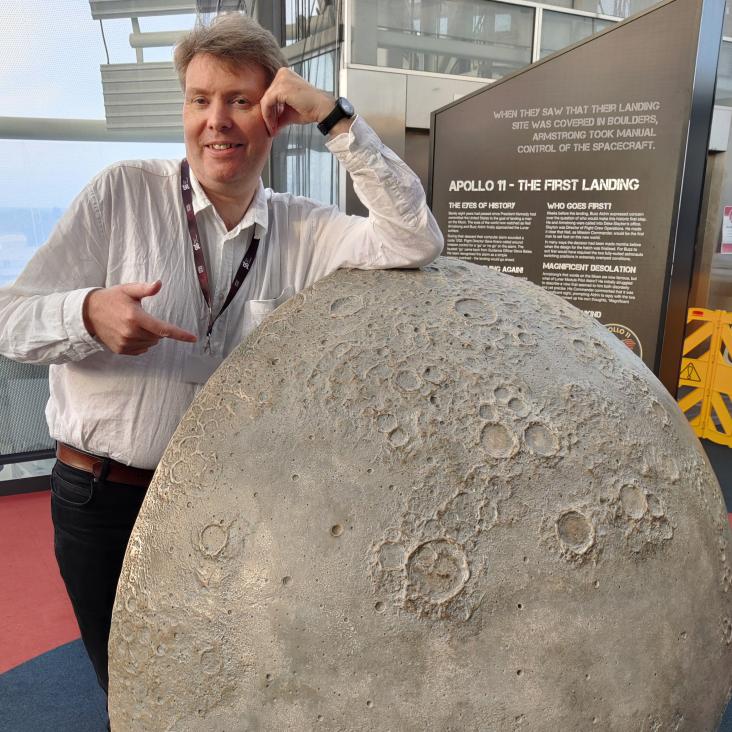Linking mineralogy and spectroscopy of highly aqueously altered CM and CI carbonaceous chondrites in preparation for primitive asteroid sample return
Meteoritics and Planetary Science Wiley (2019)
The Oxford 3D thermophysical model with application to PROSPECT/Luna 27 study landing sites
Planetary and Space Science Elsevier 182:March 2020 (2019) 104790
Abstract:
A 3D thermal model that includes a discrete subsurface exponential density profile, surface shadowing and scattering effects has been developed to simulate surface and subsurface temperatures across the Moon. Comparisons of the modelled surface temperatures with the Lunar Reconnaissance Orbiter’s Diviner Lunar Radiometer Experiment (“Diviner”) measured temperatures show significant improvements in model accuracy from the inclusion of shadowing and scattering effects, with model errors reduced from ~10 K to ~2 K for mid-latitude craters. The 3D thermal model is used to investigate ice stability at potential landing sites near the lunar south pole, studied for Roscosmos’ ‘Luna Resource’ (Luna 27) lander mission on which the ESA PROSPECT payload is planned to fly. Water ice is assumed to be stable for long periods of time (>1 Gyr) if temperatures remain below 112 K over diurnal and seasonal cycles. Simulations suggest ice can be stable at the surface in regions near to potential landing sites in permanently shaded regions and can be stable below the surface in partly shaded regions such as pole-facing slopes. The simulated minimum constant subsurface temperature (where the seasonal temperature cycle is attenuated) typically occurs at a depth of ~50 cm and therefore the minimum depth where ice can be stable is A 3D thermal model that includes a discrete subsurface exponential density profile, surface shadowing and scattering effects has been developed to simulate surface and subsurface temperatures across the Moon. Comparisons of the modelled surface temperatures with the Lunar Reconnaissance Orbiter’s Diviner Lunar Radiometer Experiment (“Diviner”) measured temperatures show significant improvements in model accuracy from the inclusion of shadowing and scattering effects, with model errors reduced from ~10 K to ~2 K for mid-latitude craters. The 3D thermal model is used to investigate ice stability at potential landing sites near the lunar south pole, studied for Roscosmos’ ‘Luna Resource’ (Luna 27) lander mission on which the ESA PROSPECT payload is planned to fly. Water ice is assumed to be stable for long periods of time (>1 Gyr) if temperatures remain below 112 K over diurnal and seasonal cycles. Simulations suggest ice can be stable at the surface in regions near to potential landing sites in permanently shaded regions and can be stable below the surface in partly shaded regions such as pole-facing slopes. The simulated minimum constant subsurface temperature (where the seasonal temperature cycle is attenuated) typically occurs at a depth of ~50 cm and therefore the minimum depth where ice can be stable is 0Small bodies science with the Twinkle space telescope
JOURNAL OF ASTRONOMICAL TELESCOPES INSTRUMENTS AND SYSTEMS 5:3 (2019) 34004
Abstract:
© 2019 Society of PhotoOptical Instrumentation Engineers (SPIE). Twinkle is an upcoming 0.45-m space-based telescope equipped with a visible and two near-infrared spectrometers covering the spectral range 0.4 to 4.5 μm with a resolving power R 250 (λ < 2.42 μm) and R 60 (λ > 2.42 μm). We explore Twinkle's capabilities for small bodies science and find that, given Twinkle's sensitivity, pointing stability, and spectral range, the mission can observe a large number of small bodies. The sensitivity of Twinkle is calculated and compared to the flux from an object of a given visible magnitude. The number, and brightness, of asteroids and comets that enter Twinkle's field of regard is studied over three time periods of up to a decade. We find that, over a decade, several thousand asteroids enter Twinkle's field of regard with a brightness and nonsidereal rate that will allow Twinkle to characterize them at the instrumentation's native resolution with SNR > 100. Hundreds of comets can also be observed. Therefore, Twinkle offers researchers the opportunity to contribute significantly to the field of Solar System small bodies research.Comparing thermal infrared spectral unmixing algorithms: applications to Bennu and other airless bodies
Meteoritics and Planetary Science Wiley 54:S2 (2019)
Evidence for ultra-cold traps and surface water ice in the lunar south polar crater Amundsen
Icarus Elsevier 332 (2019) 1-13
Abstract:
The northern floor and wall of Amundsen crater, near the lunar south pole, is a permanently shaded region (PSR). Previous study of this area using data from the Lunar Orbiter Laser Altimeter (LOLA), Diviner and LAMP instruments aboard Lunar Reconnaissance Orbiter (LRO) shows a spatial correlation between brighter 1064 nm albedo, annual maximum surface temperatures low enough to enable persistence of surface water ice (<110 K), and anomalous ultraviolet radiation. We present results using data from Diviner that quantify the differential emissivities observed in the far-IR (near the Planck peak for PSR-relevant temperatures) between the PSR and a nearby non-PSR target in Amundsen Crater.We find features in far-IR emissivity (50–400 μm) could be attributed to either, or a combination, of two effects (i) differential regolith emissive behavior between permanently-shadowed temperature regimes and those of normally illuminated polar terrain, perhaps related to presence of water frost (as indicated in other studies), or (ii) high degrees of anisothermality within observation fields of view caused by doubly-shaded areas within the PSR target that are colder than observed brightness temperatures.
The implications in both cases are compelling: The far-IR emissivity curve of lunar cold traps may provide a metric for the abundance of “micro” cold traps that are ultra-cool, i.e. shadowed also from secondary and higher order radiation (absorption and re-radiation or scattering by surrounding terrain), or for emissive properties consistent with the presence of surface water ice.


